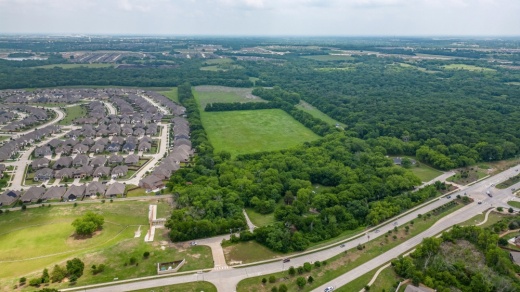Following the passage of Senate Bill 6 in 2017 and House Bill 347 in 2019, McKinney staff have begun to re-evaluate how the city will expand its existing city limits with increasingly limited annexation power. Newly proposed legislation could further restrict the ability of municipalities to expand into their ETJs.
“The main goal though is to fill ... in our city limits,” said Michael Quint, McKinney’s executive director of Development Services.
Prior to 2017, municipalities were able to annex parts of their ETJs that were contiguous to existing city limits at their discretion. This allowed for strategic growth and planning for infrastructure, such as roadways and utility lines, Quint said. McKinney did annual annexations from 2014-16 to fill in strategic areas and plan infrastructure.
While the city aims to continue expanding into the ETJ and have input on the developments planned for the area, Texas legislation has put in roadblocks to stop forced annexation. Recent reform has limited the ability of municipalities to involuntarily annex parts of an ETJ and control land use.
As a result, the projects found in McKinney’s ETJ are different in type and quantity from the years before the end of forced annexation, Quint said in a March 21 council meeting. The city is also facing additional strain on resources due to city-funded roadways and utilities being used by ETJ residents who don’t contribute taxes to fund these projects, Quint said.
Explaining growth
Residential development in the ETJ has continued to evolve to see multifamily and single family projects.
One developer working in the area is Corson Cramer Development.
The firm plans to develop 43 acres, located south of Trinity Falls at the northeast corner of Trinity Falls Parkway and Weston Road, into 104 single-family residential lots.
“This [project] is an opportunity for the homes to be a little bit more attainable, a little bit more affordable for younger families, which is really what the goal is,” co-founder and Managing Director Larry Corson said.
Corson said the high growth area and access to existing utilities made the project ideal for the development firm.
Bill Cox, who sits on the Collin County Association of Realtors board of directors, said investing in a house in the ETJ could increase the buying power of prospective home buyers.
“[For the price of] your 3,000-square-foot home in McKinney, you may be able to buy 4,000 square feet [in the ETJ],” Cox said. “Your dollar could go further out in an ETJ.”
Managing the master plan
Municipalities don’t have land-use control, which is the ability to guide development through zoning regulations and restrictions, in their ETJs. In the case of McKinney’s ETJ, the city is limited to planning subdivision authority and related horizontal permits, which includes permits for water and wastewater, Quint said.
“I get calls as the mayor constantly now for developments that are going up in the ETJ asking how could I possibly allow these things to be built, and my answer is, I didn’t allow it, our state legislators did,” McKinney Mayor George Fuller said of recent annexation reform legislation. “We have no control [in] the ETJ of what’s getting built.”
Despite the limitations McKinney has for controlling ETJ development, the area is still considered when the city plans for future infrastructure and growth, Quint said.
The city’s comprehensive plan is designed to cover the ultimate planning area for McKinney. This area spans both city limits and the ETJ.
As the ETJ develops without the city, plans made to support the area may no longer be fitting, Quint said.
“It’s really difficult to plan master-planned infrastructure when you don’t know what you’re planning for,” Quint said.
Another challenge the city faces in the ETJ is leapfrog development. That occurs when new projects jump away from the contiguous developed area to an area further away, leaving a hole, Quint said.
“When you look at our city limits, we call it the greatest example of Swiss cheese you can find,” Quint said, “There’s gaps in all of our contiguous limits.”
These holes give developers access to utility lines that are extended to service areas in city limits but pass through pockets of unincorporated land, causing additional strain on areas of McKinney, Quint said.
“The benefits of living in the country are great for those ETJ residents, but when they’re not paying the city taxes that pay for the upkeep in roadway infrastructure, water infrastructure, wastewater infrastructure ... it’s a challenge for existing residents,” Quint said.
In the face of these challenges, city staff has begun developing strategies to encourage ETJ residents and developers to annex their properties into city limits. In a March presentation, Quint detailed strategies including development partnerships, leveraging McKinney’s Capital Improvement Program and updating the development codes as ways to encourage ETJ developers to consider annexing.
“Historically, at least in McKinney’s ETJ, annexation has been very polarizing,” Quint said. “What we’re trying to do is take the polarization out of it through partnerships.”
State-level legislation
The challenge of growing city limits has been up for debate in the state Legislature.
In 2017, SB 6 passed, limiting forced annexation by municipalities.
“[Neighborhoods] can’t be annexed unless [they] want to be annexed,” Collin County Commissioner Darrell Hale said.
Hale represents Precinct 3, which includes parts of McKinney. He noted Collin County is the sole provider of vertical permits, including building permits, in unincorporated areas.
However, annexation reform bills pose a challenge to cities still looking to expand their city limits.
“I’m extremely concerned, SB 6 ... was some of the worst legislation as far as long-term city planning that’s ever been passed,” Fuller said. “I know it was not intentional, but the unintended consequences have been horrific.”
The city’s inability to annex and provide municipal services, such as police and fire support, could create a higher demand on the county, Hale said.
HB 1279, authored by Rep. Carl Tepper, R-Lubbock, would “significantly reduce” the boundaries of a city’s ETJ, Tepper said in a statement. The bill is pending in the Texas House of Representatives as of early May.
ETJ boundaries are determined by population and can reach up to 5 miles from city limits. The proposed bill would reduce those limits to a maximum of one-half mile.
“The ETJ was created to ensure that areas surrounding a municipality would grow uniformly with a municipality’s building and land standards,” Tepper said in a statement. “Given the now-voluntary nature of municipal annexation, the ETJ no longer serves its intended purpose.”
The end of forced annexation has added additional assurance for ETJ homeowners and prospective buyers, Cox said.
“[The legislation] allows people to make decisions to spend money on developments without the fear of the city coming in and taking them over without a vote,” Cox said.





